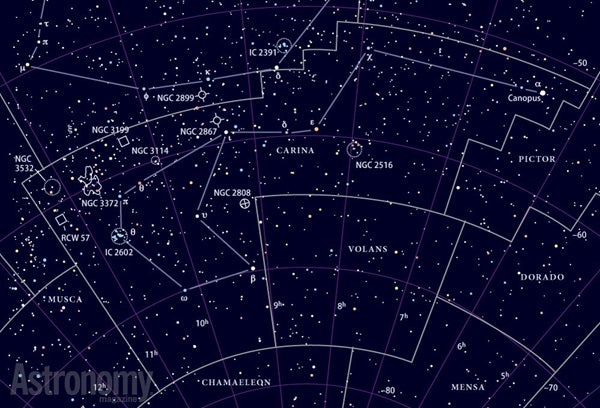Targets for March 24–31, 2016
Small telescope: Globular cluster NGC 2808
Large telescope: Elliptical galaxy NGC 2986
Large telescope: The Sextans Dwarf
Round and rich
This week’s small-telescope target is globular cluster NGC 2808 in the southern constellation Carina the Keel. It shines at magnitude 6.2 and has a diameter of 13.8′. That means it covers 20 percent as much of the sky as the Full Moon.
This magnificent object — the sky’s 10th-brightest globular cluster — is visible to sharp-eyed observers under a dark sky without optical aid. It lies in an incredible star field 3.7° west of magnitude 3.1 Upsilon (υ) Carinae.
Although the cluster is bright, you’ll have difficulty resolving NGC 2808’s stars through any telescope smaller than a 14-inch.
But you don’t need to resolve the stars for this to be a beautiful small-telescope sight. A 4-inch scope — crank the magnification past 150x — shows a blazing core surrounded by an unevenly illuminated halo.
Round-ish with a bonus
This week’s first large-scope object is elliptical galaxy NGC 2986, which lies in the sky’s largest constellation, Hydra the Water Snake. It shines at magnitude 10.8 and is slightly out-of-round, measuring 3.2′ by 2.6′.
To view this target, point your telescope 6.7° south-southwest of magnitude 4.1 Upsilon1 Hydrae. No amateur instrument will reveal a lot of detail in this object, but what you will see is an evenly illuminated central region that spans more than three-quarters of the galaxy’s total diameter. The thin outer halo is visible at magnifications above 150x through 10-inch and larger scopes.
When you’re through with NGC 2986, bump up the power a bit and observe the magnitude 14.4 spiral PGC 27873, which lies 2′ west-southwest of the brighter elliptical galaxy.
I assure you, it is visible
This week’s second large-telescope target is the Sextans Dwarf, a dwarf spheroidal galaxy in the constellation Sextans the Sextant. And it’s a tough catch.
You’ll find this faint target 1.8° southeast of magnitude 4.5 Alpha (α) Sextantis. Astronomers discovered it in 1990 during a photographic survey. It lies only 320,000 light-years away (close for a galaxy), and it — dare I say — “shines” at magnitude 10.4, but it’s so large that it has a surface brightness barely above that of the night sky.
How large? This object measures a whopping 26.9′ by 5.9′, meaning it covers two-thirds the area of the Full Moon. To see it, you’ll need at least a 16-inch telescope. Insert your lowest-power eyepiece and slowly scan the area, looking for a tiny increase in the background glow.
Expand your observing at Astronomy.com
The Sky this Week
Get a daily digest of celestial events coming soon to a sky near you.
Observing Basics
Find more guidance from Senior Editor Michael E. Bakich with his Observing Basics video series.










